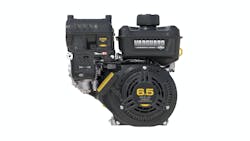Vanguard Single-Cylinder Engines
Briggs & Stratton Commercial Power has introduced the first of a complete line of single-cylinder, horizontal-shaft commercial gasoline engines under its premium Vanguard brand. According to the company, “the new Vanguard engines are built from the ground up, based on customer input, and are developed around key areas of performance critical to improving overall productivity, including starting, maintenance intervals, service and support, and total cost of ownership.” The new line will span from 5 to 13 gross horsepower (3,600 rpm per SAE J1940) to meet power requirements for a wide range of global commercial applications.
“For decades, manufacturers have been modifying old designs,” says Jim Cross, marketing manager, Briggs & Stratton Commercial Power. “We went out and asked people what they wanted and needed out of a single-cylinder engine—before we even started designing this platform. We interviewed hundreds of stakeholders including rental houses, end users, and dealers worldwide to better understand the issues they face—the need for improved starting, reduced maintenance, less noise and vibration, and better service and support.”
The ground-up design process, says Cross, allowed comprehensively engineering all-new carburetion, ignition, and combustion systems to promote reliable starting in any environment. To ensure four-season starting, the engine is designed to start at temperatures as low as -20 F (assuming proper starting procedures and fuel and oil specifications). To further improve starting, all surfaces inside the carburetor that contact fuel feature a special corrosion- and stale- fuel-resistant plating.
The new line of engines also includes an advanced version of the company’s TransportGuard, providing a single ignition and fuel shut-off designed to prevent oil dilution during transport. The lever now incorporates throttle control, expanding application opportunities and repower capabilities, says the company, and the engine’s dimensions and bolt configuration make it a drop-in solution for equipment powered by other engines.
The engine also features an oil-management system that allows the engine to run safely for up to 200 hours between oil changes. The standard-equipment, fully-cyclonic, air-filtration system is designed to lessen downtime by extending the recommended air-filter-replacement interval to 600 hours. The Vanguard range’s main components, says the company, are engineered to lessen the impact of vibration on performance, as well as on the engine and equipment—while also enhancing operator comfort. To reduce overall engine noise, acoustic engineers reduced both decibel levels and the perceived harshness of the engine’s sound.
“We didn’t stop with performance,” says Cross. “Our feedback indicated that customers are concerned about service and support, and our support system—from training, to warranty processing, part availability, and technical service—is designed to keep the customer productive and to lower overall costs.”
Through a single national distributor with nine locations in the United States, says Cross, Vanguard provides next-day delivery of more than 50,000 parts and replacement engines to their commercial dealer network. Training resources are available both online and in person, he says, with 11 training centers that provide “on-demand” certifications and advanced EFI training. Support resources also include online technical support, a commercial telephone “Answer Center,” and a three-year commercial limited warranty.
The first available model in the new single-cylinder line, the 6.5-horsepower Vanguard 200, will be available to OEMs and for engine repowers in 2018. The remaining models—ranging from 5 to 13 horsepower—will be introduced over the next two years.
